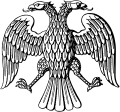Russian Democratic Federative Republic
| Russian Democratic Federative Republic Российская Демократическая Федеративная Республика Rossiyskaya Demokraticheskaya Federativnaya Respublika | |
|---|---|
| 1918–1918 | |
 Russia between December 1917 and January 1918, after recognition of Finnish independence and before other declarations of independence. | |
| Capital | Petrograd |
| Common languages | Russian |
| Government | Federative presidential constitutional republic |
| Chairman | |
| Legislature | Russian Constituent Assembly |
| Historical era | Russian Revolution |
| 25 November 1917 | |
• Resolution adopted[1] | 19 January 1918 |
|
19 January 1918 | |
• Final draft of constitution | 20 January 1920 |
| Currency | Russian ruble |
| ISO 3166 code | RU |
| |
| Russian Wikisource has original text related to this article: |
The Russian Democratic Federative Republic (Russian: Российская Демократическая Федеративная Республика, tr. Rossiyskaya Demokraticheskaya Federativnaya Respublika)[2] was a state declared in 1918 in the Russian Socialist Federative Soviet Republic (Russian SFSR) during the Russian Revolution of 1917.[3] It was formally declared on 19 January 1918[1] when the democratically elected Russian Constituent Assembly drafted and adopted the "Resolution on the form of government of Russia", declaring Russia to be a democratic federal republic. However, the Assembly was dissolved on the same day by the All-Russian Central Executive Committee, meaning the declaration was not carried out.
Governmental structure
According to the constitution, Russia was to be declared a democratic federal republic. The fundamental basis of the state was representative democracy and federation of both[4] national and territorial autonomous oblasts.[5] This was in contrast to the Decembrist constitution project, which proposed a federal constitutional monarchy on an economic basis. For the first time, the unitary structure of Russia would have been officially abolished and the country declared a federation, marking the start of the federalist period in Russian history.[1]
Civil rights and duties
The Constitution granted universal suffrage for all citizens of the Republic aged 20 or older.[6] This would have been five years lower than in the former Russian Empire.
Most civil duties, such as conscription and taxes, were inherited from the legislation of the Russian Empire.
Head of state
The head of state would have been the President of the Russian Democratic Federative Republic, elected for a one-year term[6] by a majority vote in parliament involving the deputies of both chambers.[5] Presidential powers were nearly identical to those of the Emperor:[6]
- Appointment of several government officials and their removal of office;
- Commander-in-chief of the Russian Army;
- Decisions on the foreign policy of Russia;
- Right to propose laws;
- Control over governmental structures member and functioning;
- Control over law enforcement;
- Exercising and overseeing management in Russia.
The President would have been responsible for his work before the parliament. A similar approach to presidential power, there termed Ersatzkaiser, was later used in the German constitution of 1919.
Due to the cancellation of the Constitution, no person was ever elected to this office.
Legislation
According to the final draft of the Constitution, adopted in Paris on 20 January 1920, legislative power was to be held by a bicameral parliament. The State Council of the Russian Democratic Federative Republic would form the upper house, elected by regional legislatures (sejms),[5] while the State Duma of the Russian Democratic Federative Republic would form the lower house, directly elected by citizens of the Republic.[5][7]
Constituent powers to create a new constitution and change the type of government were allocated to the Russian Constituent Assembly.[5]
See also
References
- 1 2 3 http://www.prof.msu.ru/publ/book/round1.htm
- ↑ (in Russian) Decree on system of government of Russia
- ↑ (in Russian) Гаранжа, Анатолий Петрович Всероссийское Учредительное собрание о государственном устройстве страны
- ↑ (in Russian) Гаранжа, Анатолий Петрович Всероссийское Учредительное собрание о государственном устройстве страны
- 1 2 3 4 5 (in Russian) THE POLITICAL SYSTEM OF RUSSIA IN PROGRAMS OF WHITE MOVEMENT AND WHITE EMIGRATION Bukhvostovoj D.V.
- 1 2 3 (in Russian) Details on 1917 project of the constitution of the Russian Democratic Federative Republic //LAW.EDU.RU
- ↑ Bukhvostovoj, D.V. "POLITICAL DEVELOPMENT OF RUSSIA IN THE PROGRAMS OF WHITE MOVEMENT AND WHITE EMIGRATION" (PDF). http://umc.gu-unpk.ru/. Oryol State Technical University, Oryol, Russia. Retrieved 27 November 2017. External link in
|website=(help)
.svg.png)
